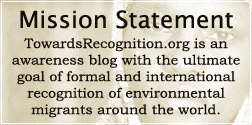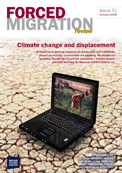(CNN) November 17, 2010 – The devastating effects of climate change and conflicts fought over ever-scarcer resources such as water could cause a surge in migration that experts fear the world is totally unprepared for.
At least one billion people will be forced from their homes between now and 2050 by such forces, the international charity group Christian Aid predicted in a recent report.
This forecast is backed up by a new report by British consultancy Maplecroft that says developing countries in Asia and Africa face the biggest risks from global warming in the next 30 years. Poverty and large low-lying coastal regions prone to flooding and cyclones make Bangladesh the most exposed country while India, in second place, is vulnerable because of pressures from a rising population of 1.1 billion.
Read the full report listing countries most at risk
The United Nations Population Division (UNDP) estimates there are now an unprecedented 200 million international migrants and refugee chief Antonio Guterres is urging richer countries to share the global refugee burden more fairly with developing nations to “increase its solidarity” with them.
Which countries are most ‘welcoming’ to asylum seekers?
But while many people in the West fear an influx of migrants from poorer countries, security experts say most of those affected will stay near their homes — putting even more pressure on the poorest countries and potentially fueling yet more conflicts.
The U.N. refugee agency says there
are 1.7 million Afghans in Pakistan, for example, and that, contrary to many people’s beliefs, more than three-quarters of the world’s refugees stay within Asia and Africa.
Tell us about your migration. Send us your stories, images or video
But it would take just a fraction of those fleeing climate change and conflict to move to the developed world to dwarf Europe’s current annual net gain from international immigration of about 1.8 million people, experts say.
These are the “push factors” that drive migration but even during the global recession there are “pull factors,” such as gaps in the labor market, that also draw in skilled and unskilled workers to richer countries that compensate for falling birth rates and pay the pensions of more older people.
Confusion reigns about both factors, according to experts broadly supportive of immigration who say the growing victimization of both legal and illegal immigrants by lawmakers and the media across Europe is hindering debate on the issue.
The often misleading coverage of migration also belies the fact that asylum claims have fallen sharply in the last decade: from 450,000 in 1999 to 270,000 last year, according to the Organisation for Economic Co-Operation and Development (OECD).
These numbers fail to tell the whole story of course: even with higher borders and tougher laws, it is difficult for a country to keep out those who determined to enter. More enter by overstaying visas or using faked papers than on boats crossing the Mediterranean from Africa, and are harder to detect, experts say.
“Stronger borders will keep out the immigrants we do need, and evidence has shown they don’t really keep out illegal migrants; they just force them underground, putting them at greater risk from people traffickers or the black labor market,” said Khalid Koser from the Geneva Centre for Security Policy. “So if Bangladeshis fleeing rising sea levels in the Bay of Bengal due to climate change want to come to Britain, then they’ll find a way.”
The widely held belief around the world is that immigrants — especially asylum seekers — are “spongers” on benefits who cause the population to soar, cause crime and even terrorism while contributing little to society in return. Anecdotal evidence about this is often compelling, but experts say when the objective figures are studied these fears are revealed to be myths.
For a start even those immigrants who are under the radar and don’t pay taxes still do jobs that need to be done. “Most migrants work,” said Koser, “they pay taxes and most don’t draw much on benefits.
So overall there’s almost certainly a net gain from migration.”
But the U.N.’s plea for the West to accept more refugees would seem to be falling on deaf ears. Even center-left politicians such as former British Prime Minister Tony Blair writes in his memoirs that the 1951 refugee convention that compels all countries to accept those fleeing persecution or violence had allowed for an “explosion” of asylum claims.
He said the treaty that was written in response to the horrors of World War II was “utterly incapable” at coping with the migration levels of the modern era. “Essentially Britain, like all European countries, had inherited the post-war, post-Holocaust system and sentiment on asylum,” Blair says in “A Journey.” The painful stories of refugees fleeing from Hitler and the Nazis and being turned away produced a right and proper revulsion.
“It was an entirely understandable emotion in the aftermath of such horror,” Blair wrote, but added that as Britain became known as “the asylum capital of Europe” he came to the conclusion that tougher rules were needed on immigration.
So obtaining global agreement on a U.N. treaty — especially one intended to be more generous to refugees — would appear to be a tall order. “Migration strikes at the heart of national identity,” said Koser. “No state is going to give up control of this issue, just as it wouldn’t give up control of defence or the economy.”
For this same reason many see little chance that the European Commission is likely to achieve its goal of agreeing a common policy on immigration by 2012. Countries in the 27-nation bloc have differing ways of handling the challenges: Italy, for example, has struck deals with Libya to intercept migrants; France is unilaterally expelling the Roma people, who have a legal right under EU laws to be in that country; Greece has been accused of abuses including sending children back across the border to Turkey while Spain has granted several amnesties to illegal immigrants.
Across the EU, several countries are also demanding the lifting of quotas on immigrants with certain skills, especially in financial, IT and science sectors. Last month British business leaders warned that a cap on the number of immigrants from outside the EU was causing problems for companies trying to recruit the best international talent. The EC has also made clear the 27-nation’s bloc need for more skilled workers and believes a proposed “Blue Card” scheme will alleviate the problem.
However even many economists say individual countries must be wary of satisfying business ahead of its national interest.
First societies must become strong enough to cope with newcomers, according to Hugo Brady, a senior research fellow at the Centre for European Reform, a think tank that focuses on the EU. “It’s disingenuous to say business needs migrants and we’re all getting older so it’ll all be fine. It skips over the fact that it doesn’t follow that we can solve our demographic problems with lots of immigration.
“And it ignores the fact that our societies need to be set up for that. I’d be sceptical that societies could absorb immigration on the scale suggested by our demographics.
“The nub of the entire issue is whether Swedish society, for instance, is strong and confident enough, as the United States is, to absorb large numbers of newcomers.
“What we have here in Europe is a very high quality of life which is protected and guarded. But unfortunately a large welfare state and conservative societies don’t really lend themselves to large numbers of people coming and going.
“To a certain extent it’s illusory that countries can control immigration: really it can only be sensibly managed, but nothing controls immigration numbers like the economy,” Brady said, adding that global migration had fallen during the recession.
There are now 200 million migrants in the world, one in 35 people, equivalent to the population of Brazil, the fifth most populous country in the world. Many see that figure as terrifying, but an optimist might see the flip side — that one in 35 is just 3 percent, which means 97 percent of the world’s population never moves — as equally valid. It could be said that one’s position on the migration debate really boils down to whether one sees the glass as half full or half empty.
Source: CNN




Thanks for this news link Kayly!